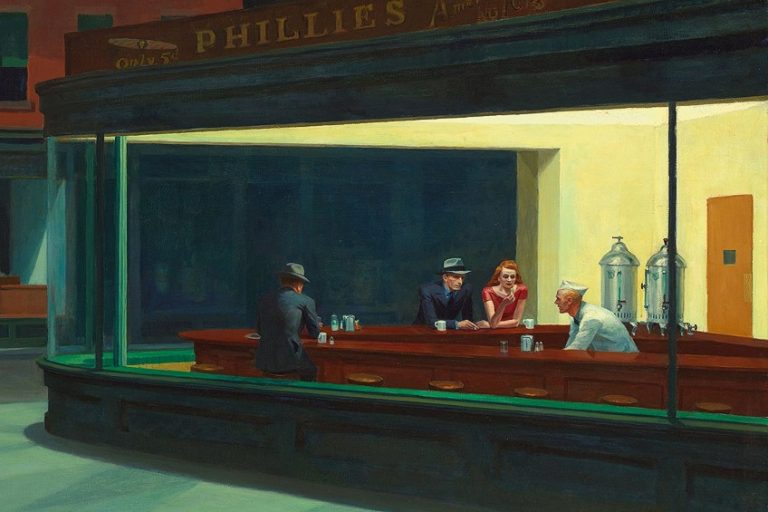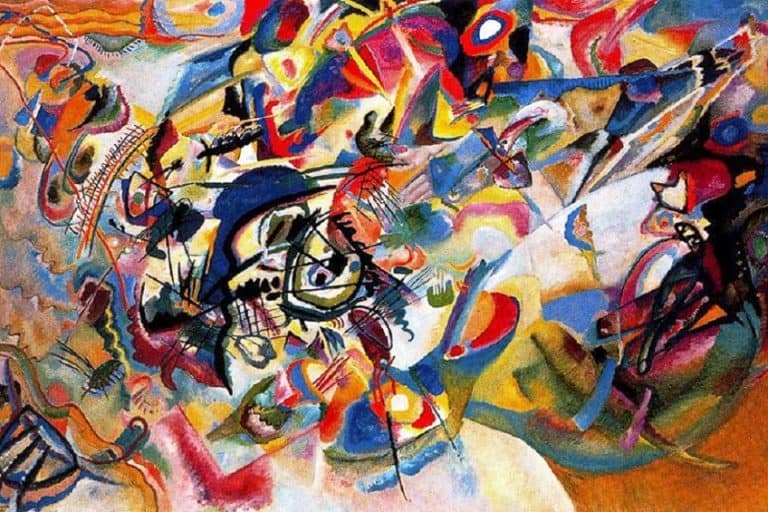“Waterfall” by M.C. Escher – An Optical Illusion Analysis
Waterfall, a captivating lithograph by the renowned Dutch artist M.C. Escher, exemplifies his mastery of optical illusion and mathematical precision. Created in 1961, the work presents a seemingly impossible architectural structure where water appears to defy gravity as it perpetually cascades downward. Escher’s meticulous attention to detail and manipulation of perspective draw viewers into a world where reality and imagination intertwine seamlessly. Through Waterfall, Escher challenges traditional notions of space and dimension, inviting audiences to contemplate the boundaries of perception and the nature of visual reality. This iconic piece stands as a testament to Escher’s ingenuity and continues to intrigue and inspire art enthusiasts and mathematicians alike with its enigmatic allure.
Table of Contents
Key Takeaways
- Escher’s Waterfall lithograph, created in 1961, is a classic example of the artist’s unique approach to perspective and space.
- The artwork features an optical illusion of water defying gravity, representative of Escher’s interest in perpetual motion and impossible constructions.
- Waterfall has had a lasting impact on both the artistic and scientific communities, highlighting Escher’s legacy as an artist who bridged the gap between art and mathematics.
Historical Context
| Artist | M.C. Escher (1898 – 1972) |
| Date Created | 1961 |
| Medium | Lithograph |
| Genre | Surrealism and Optical illusion |
| Period/Movement | Modern Art and Op Art |
| Dimensions (cm) | 38 x 30 |
| Series/Versions | N/A |
| Where Is It Housed? | Private collections; museum’s worldwide |
| What It Is Worth | Estimated value varies based on factors such as condition, provenance, and market demand. Escher’s works can range from thousands to millions of dollars at auctions and private sales |
Maurits Cornelis Escher, a Dutch artist renowned for his intriguing works that explore perspective and space, created the lithograph Waterfall in 1961. This piece stands out for its clever use of a paradoxical construction where water appears to flow uphill before cascading down the same waterfall—a visual that defies the laws of physics and captivates the viewer. Escher’s mastery in illustrating impossible realities is evident in this artwork, as it showcases his ability to manipulate geometric patterns and perspectives to create an endless loop, suggesting a perpetual motion machine.

Waterfall is not just a visual spectacle but also serves as a testament to Escher’s impactful contributions to both art and mathematics. His explorations transcend traditional boundaries, making his work compelling for both aesthetic appreciation and intellectual curiosity. The lithograph invites a deeper artistic analysis, while simultaneously posing questions about reality and illusion. It has become one of Escher’s most iconic creations, reflecting his fascination with infinity and his skill in rendering it artistically. The Waterfall lithograph was created by Dutch artist M. C. Escher in 1961, during a period where he explored mathematical concepts through art, resulting in fascinating optical illusions.
Use of the Lithograph
Lithography, a printing process that utilizes a flat stone or metal plate, was the technique Escher employed to produce Waterfall. The medium allowed him to achieve precise detailing necessary for his complex designs. The lithograph presents a watercourse that seemingly defies the laws of physics, cleverly crafted by Escher to loop water from the bottom to the top in an impossible perpetual motion.
This visual paradox echoed the artist’s interest in the infinite and the exploration of eternity within a two-dimensional plane.
Artistic Analysis
This section delves into the creative process and the techniques employed by M.C. Escher in Waterfall, as well as the influences and thematic concepts that define the work.

Creation and Technique
M.C. Escher’s Waterfall, created in 1961, is a lithograph that exemplifies the artist’s mastery of transforming two-dimensional surfaces into complex visual narratives. Escher’s meticulous application of lithographic techniques on paper allowed him to construct an illusion of depth through precise linework and shading.
His intention was not simply to capture the likeness of natural forms like moss or waterwheels but to play with their structural possibilities.
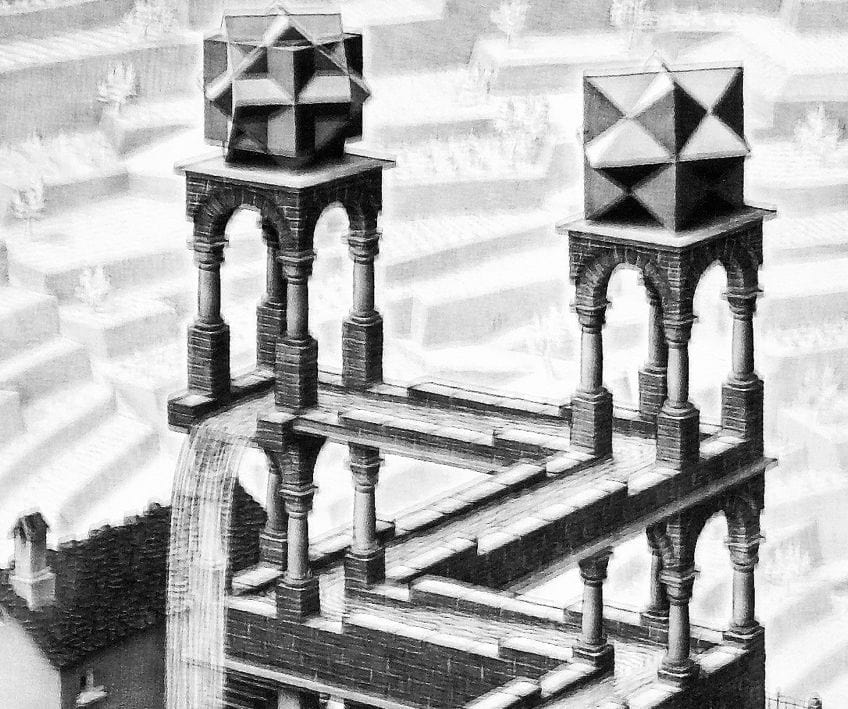
Influences and Collaborations
Escher was influenced by British mathematician Roger Penrose and Swedish artist Oscar Reutersvärd, who both explored the concept of impossible objects. These influences are evident in Escher’s Waterfall, where he presents Penrose Triangles, a classic example of an impossible figure.
This print also reflects the impact of journals like the British Journal of Psychology, in which Penrose published his ideas on visual paradoxes.

Perception of Reality
In Waterfall, Escher challenges the viewer’s perception of reality and unreality by juxtaposing conflicting proportions in a believable framework. The work projects an illusion of depth and a functioning perpetual motion machine, which defies the laws of physics.
This is a concept often associated with evaporation but here reversed to create an endless cycle.
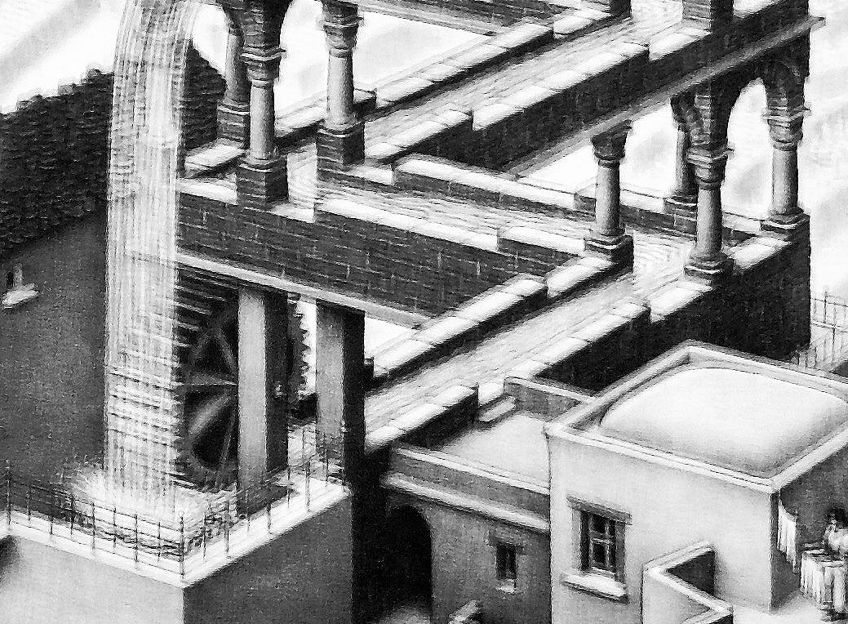
Escher’s Imaginative Concepts
Escher’s imagination extended beyond traditional boundaries, as evidenced by other works like Circle Limit I or Drawing Hands. Waterfallaligns with Escher’s fascination with blending fantasy and reality, as seen in prints like Belvedere. The water depicted defies gravity by flowing upwards, reminiscent of an impossible object.
In this way revealing his profound interest in challenging the viewer’s perspective and understanding of space.

Legacy and Impact
M. C. Escher’s Waterfall has left an indelible mark on both popular culture and the academic spheres of mathematics and science through its compelling use of visual paradoxes and intricate structures.

Cultural Significance
Waterfall by M.C. Escher is an extraordinary work that has transcended the traditional boundaries of art, captivating a diverse audience well beyond the typical art community. This lithograph is renowned for depicting a visual paradox, where a physically impossible perpetual motion machine appears to function within the laws of reality. The water seems to flow uphill in a loop, defying the laws of physics and mesmerizing viewers.
Escher’s intricate design features the Penrose Triangle, an impossible object that is central to the illusion, indicating his ability to manipulate our perception of reality.
This work’s cultural impact is evident in its continued influence on various forms of media and entertainment. The visual paradoxes created by Escher are often replicated or serve as inspiration in movies, books, and art, thus allowing Waterfall to maintain its relevance in contemporary creative expressions.
Influence on Mathematics and Science
Escher’s Waterfall has piqued the interest of mathematicians and scientists through its clever use of geometric shapes, which include the polyhedra and the visually perplexing watermill. The intertwining of art with mathematical concepts in his lithograph inspires inquiry into the nature of space, form, and perspective. The depiction of the impossible perpetual motion machine provokes questions regarding the theoretical limits within physics, while simultaneously representations like the Penrose Triangle have been studied for their implications in the field of topology.
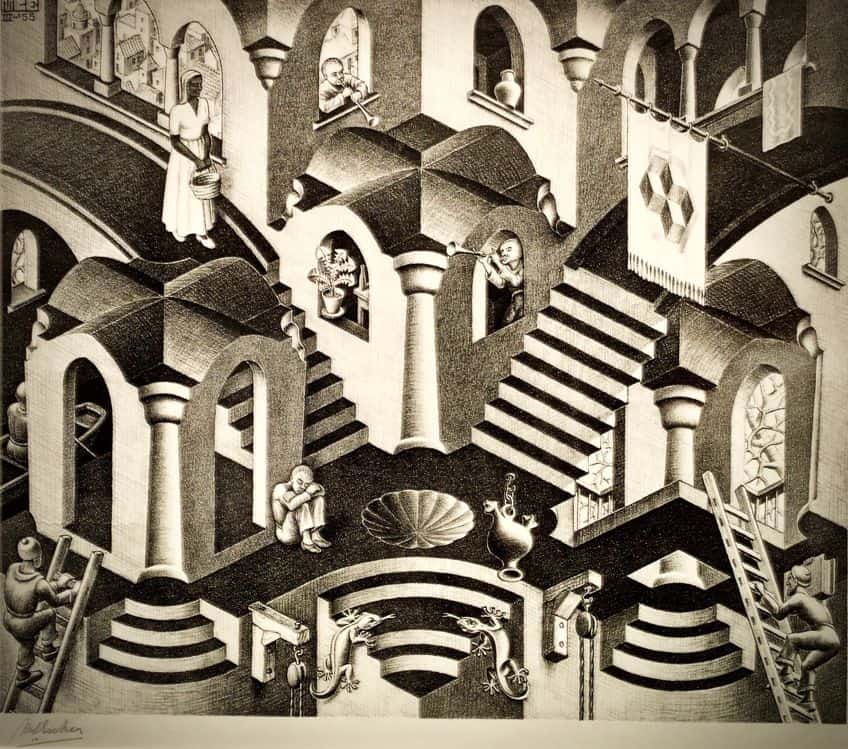
His work has been particularly influential in the realm of mathematics, where themes from his other famous pieces, such as Drawing Hands, Relativity, and Ascending and Descending, explore infinity and hyperbolic geometry. M.C. Escher’s collaboration with mathematician Roger Penrose, who introduced him to the Penrose Triangle, is a notable example of how art and science can fuel each other’s evolution, leading to new insights across disciplines. The impact of Escher’s work is evident in education as well, where his creations are used to facilitate the understanding of complex scientific and mathematical theories. The images, while enigmatic and challenging to the viewer, serve as a bridge between abstract scientific concepts and tangible visual representation, often becoming a leat for students and enthusiasts to explore the fringes of mathematical thought.
Escher’s Waterfall stands as a testament to the artist’s unparalleled ability to challenge conventional perceptions and transcend the limitations of visual reality. Through meticulous craftsmanship and mathematical precision, Escher invites viewers into a world where the impossible becomes tangible, where water flows endlessly uphill and architectural structures defy gravity. As a hallmark of Escher’s exploration into the realms of optical illusion and surrealism, Waterfall continues to captivate audiences, sparking curiosity and contemplation about the nature of perception and the boundaries of artistic possibility. Its enduring allure reaffirms Escher’s legacy as a visionary artist whose work transcends time and continues to inspire generations of admirers and scholars alike.
Frequently Asked Questions
How Does M.C. Escher’s Waterfall Depict an Impossible Reality?
M.C. Escher’s Waterfall lithograph features a watermill connected to an elevated aqueduct and waterwheel. It is constructed in such a way that the water appears to flow uphill before reaching the wheel, defying the laws of physics and creating a visual paradox. This illusion is achieved by the deliberate crafting of the aqueduct’s shape and the positioning of the watermill, playing tricks on the viewer’s perception.
What Techniques Did M.C. Escher Use in Creating Waterfall?
Escher employed a meticulous lithography process coupled with his deep understanding of mathematics to bring Waterfall to life. He used the concept of the Penrose triangle, also known as the “impossible triangle”, to form the core of the waterfall’s structure, which logically cannot exist in three-dimensional space. This technique of incorporating impossible figures demonstrates Escher’s ability to render abstract mathematical ideas into concrete, albeit paradoxical, visual forms.
Isabella studied at the University of Cape Town in South Africa and graduated with a Bachelor of Arts majoring in English Literature & Language and Psychology. Throughout her undergraduate years, she took Art History as an additional subject and absolutely loved it. Building on from her art history knowledge that began in high school, art has always been a particular area of fascination for her. From learning about artworks previously unknown to her, or sharpening her existing understanding of specific works, the ability to continue learning within this interesting sphere excites her greatly.
Her focal points of interest in art history encompass profiling specific artists and art movements, as it is these areas where she is able to really dig deep into the rich narrative of the art world. Additionally, she particularly enjoys exploring the different artistic styles of the 20th century, as well as the important impact that female artists have had on the development of art history.
Learn more about Isabella Meyer and the Art in Context Team.
Cite this Article
Isabella, Meyer, ““Waterfall” by M.C. Escher – An Optical Illusion Analysis.” Art in Context. February 23, 2024. URL: https://artincontext.org/waterfall-by-m-c-escher/
Meyer, I. (2024, 23 February). “Waterfall” by M.C. Escher – An Optical Illusion Analysis. Art in Context. https://artincontext.org/waterfall-by-m-c-escher/
Meyer, Isabella. ““Waterfall” by M.C. Escher – An Optical Illusion Analysis.” Art in Context, February 23, 2024. https://artincontext.org/waterfall-by-m-c-escher/.





